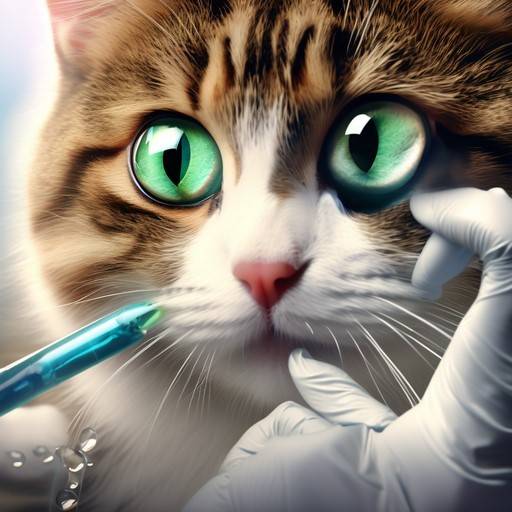Cat Eye Infection: Spotting the Signs and Taking Action
Learn how to spot and act against cat eye infections. Discover the signs, symptoms, and treatment options for cat eye infections.
Introduction
Eye infections in cats are prevalent and can impact felines regardless of their age or breed. These infections can range from mild to severe and can be caused by various factors, such as bacteria, viruses, injuries, or underlying health conditions. Recognizing the early signs of a Feline Ocular Infection It’s vital to promptly seek veterinary attention. and preventing further complications that could potentially threaten your cat’s vision.
Identifying the Signs of a Cat Eye Infection
One of the first steps in addressing a cat eye infection is being able to recognize the telltale signs. Here are some common symptoms to watch out for:
- Eye Discharge: A clear, yellow, or green discharge from the eye(s) can be an indication of an infection.
- Excessive Tear Production: Watery or excessively teary eyes may signal an underlying issue.
- Squinting or Keeping the Eye(s) Closed: This behaviour can indicate discomfort or sensitivity to light.
- Eye Redness or Swelling: Redness, inflammation, or swelling around the eye area is a common sign of infection.
- Pawing or Rubbing at the Eye(s): If your cat is constantly pawing or rubbing their eyes, it could be a sign of irritation or discomfort.
- Cloudiness or Opacity of the Eye: A cloudy or opaque appearance in the eye(s) may indicate a more serious infection or injury.
If you notice any of these symptoms, it’s essential to seek veterinary attention promptly, Delaying medical intervention may result in additional complexities and the risk of vision impairment.
Understanding the Causes of Cat Eye Infections
Cat eye infections can arise from various underlying causes, including:
- Bacterial Infections: Infections caused by bacteria, such as Staphylococcus or Streptococcus, are common and can result from injuries, foreign objects, or compromised immune systems.
- Viral Infections: Viruses like feline herpesvirus and feline calicivirus can cause upper respiratory infections, which can lead to eye infections in cats.
- Fungal Infections: While less common, fungal infections can occur and may be more challenging to treat.
- Injuries or Foreign Objects: Scratches, cuts, or foreign objects in the eye can introduce bacteria and lead to infections.
- Allergies: Environmental allergens or certain medications can trigger allergic reactions, leading to eye irritation and potential infections.
- Preexisting health issues: Ailments such as feline immunodeficiency virus (FIV) and feline leukemia virus (FeLV) or diabetes can compromise the immune system and increase the risk of eye infections.
It’s essential to pinpoint the root cause of the feline ocular infection to ensure proper treatment and mitigate the risk of additional issues arising.
| Symptom | Possible Cause |
| Eye Discharge | Bacterial, viral, or fungal infection |
| Excessive Tear Production | Allergies, injury, or irritation |
| Squinting or Keeping Eyes Closed | Discomfort or light sensitivity |
| Eye Redness or Swelling | Inflammation or infection |
Treating a Cat Eye Infection
Once a cat eye infection has been diagnosed, your veterinarian will recommend the appropriate treatment plan, which may include:
- Topical Antibiotics: Antibiotic eye drops or ointments are often prescribed to combat bacterial infections.
- Antiviral Medications: In cases of viral infections, antiviral medications may be necessary.
- Anti-inflammatory Drugs: These medications can help reduce swelling and discomfort associated with eye infections.
- Eye Flushing or Cleaning: Your vet may recommend flushing or gently cleaning the affected eye(s) to remove debris or discharge.
- Treating Underlying Conditions: If the eye infection is related to an underlying health condition, addressing the root cause will be crucial for resolving the issue.
Adhering closely to your veterinarian’s guidance and completing the entire treatment regimen is crucial, even if there’s an initial improvement in symptoms. Stopping treatment prematurely can lead to a recurrence of the infection or resistance to medication.
Preventive Measures for Maintaining Healthy Cat Eyes
While cat eye infections can occur despite our best efforts, there are several preventive measures you can take to reduce the risk and maintain your feline friend’s eye health:
- Regular Grooming: Gently cleaning your cat’s eyes and face with a damp, soft cloth can help remove any debris or discharge that could lead to infections.
- Providing a Clean Environment: Make sure your cat’s environment remains tidy, and devoid of dust and potential irritants, and regularly sanitize their bedding and litter box.
- Prompt Treatment of Injuries: If your cat sustains any eye injuries or scratches, seek veterinary attention immediately to prevent the development of infections.
- Regular visits to the veterinarian for check-ups: Regular check-ups with your veterinarian can help detect and address any potential health issues, including eye problems before they become more serious.
- Proper Nutrition: A balanced, high-quality diet can support your cat’s overall health and immune system, reducing the risk of infections.
- Flea and Parasite Control: Fleas and other parasites can transmit diseases or cause irritation, leading to potential eye infections in cats.
By implementing these preventive measures and being vigilant about your cat’s eye health, you can reduce the risk of cat eye infections and ensure your furry companion maintains clear, comfortable vision.
Conclusion
Cat eye infections can be distressing for both felines and their owners, but with proper knowledge and prompt action, they can be effectively managed and treated. By recognizing the signs, understanding the potential causes, and seeking veterinary care, you can ensure your furry friend receives the appropriate treatment and avoids further complications. Remember, preventive measures like regular grooming, a clean environment, and routine check-ups can go a long way in maintaining your cat’s eye health and overall well-being.
Frequently Asked Questions about Cat Eye Infection
How can I treat my cat’s eye infection?
It’s generally not advisable to attempt treating your cat’s eye infection at home without consulting a veterinarian first. Eye infections can have various underlying causes, and improper treatment can worsen the condition or lead to further complications. It’s best to have your feline companion examined by a professional.
Your veterinarian will likely prescribe appropriate medications based on the type and severity of the infection. Common treatments include topical antibiotic eye drops or ointments for bacterial infections, antiviral medications for viral infections, and anti-inflammatory eye drops to reduce swelling and discomfort.
In some cases, your vet may recommend gently flushing or cleaning the affected eye(s) to remove any debris or discharge. They may also advise treating any underlying health conditions contributing to the eye infection.
Following your veterinarian’s instructions precisely and completing the full course of treatment is crucial, even if the symptoms seem to improve initially. Stopping treatment prematurely can lead to a recurrence of the infection or resistance to medication.
Will a cat eye infection heal on its own?
In some mild cases, a cat’s eye infection may clear up on its own without specific treatment, especially if it’s caused by a minor irritation or injury. However, it’s generally not recommended to rely on self-healing, as eye infections can quickly worsen and lead to more severe complications if left untreated.
Eye infections caused by bacteria, viruses, fungi, or underlying health conditions are unlikely to resolve without proper medical intervention. Leaving these types of infections untreated can result in complications such as corneal ulcers, scarring, or even vision loss.
It’s essential to monitor your cat’s eye condition closely and seek veterinary attention promptly if you notice any signs of infection, such as eye discharge, redness, swelling, or excessive tearing. Early treatment can often prevent the infection from worsening and reduce the risk of long-term eye damage.
While some minor eye irritations may resolve independently, it’s always safer to have your veterinarian examine your cat’s eyes and provide the appropriate treatment to ensure a full recovery and prevent potential complications.
What does an infected cat eye look like?
An infected cat eye can exhibit various signs and symptoms depending on the underlying cause and severity of the infection. Here are some common indicators of an eye infection in cats:
- Eye discharge: One of the most noticeable signs is discharge from the affected eye(s). This discharge can range in color from clear, yellow, or green, and may be watery or thick and mucus-like.
- Redness or swelling: The area around the eye (conjunctiva) may appear red, inflamed, or swollen due to the infection.
- Squinting or keeping the eye closed: Cats may squint or keep the affected eye partially or fully closed due to discomfort, light sensitivity, or irritation caused by the infection.
- Excessive tearing or wetness: Some eye infections can cause excessive tear production, leading to a constantly watery or wet appearance around the eye area.
- Cloudiness or opacity: In severe cases, the eye itself may appear cloudy or opaque, indicating a deeper infection or potential corneal involvement.
- Pawing or rubbing at the eye: Your cat may persistently paw or rub at the infected eye due to the discomfort or irritation caused by the infection.
- Visible structural changes: In advanced cases, you may notice visible changes to the eye’s structure, such as swelling, discoloration, or deformities.
It’s important to note that some eye infections may not exhibit all of these symptoms, or they may present with varying degrees of severity. If you notice any signs of eye discomfort or abnormalities in your cat, it’s best to have a veterinarian examine their eyes promptly to determine the cause and provide appropriate treatment.
Can a cat survive an eye infection?
Yes, most cats can survive an eye infection if it is promptly diagnosed and treated properly. However, the severity of the infection and the underlying cause can impact the prognosis.
Mild to moderate eye infections, such as those caused by minor irritants or bacterial infections, are generally treatable with appropriate medication and care. When caught early and treated according to the veterinarian’s instructions, these infections typically resolve without causing permanent damage or vision loss.
More severe or chronic eye infections, particularly those caused by viruses, fungi, or underlying health conditions, may require more intensive treatment and monitoring. In some cases, complications like corneal ulcers, scarring, or even vision loss can occur if the infection is left untreated or inadequately managed.
If you observe any indications of an eye infection in your cat, it’s imperative to promptly seek veterinary care. Early diagnosis and treatment can significantly improve the chances of a full recovery and prevent potential complications that could threaten your cat’s vision or overall health.
However, even with proper treatment, some severe or long-standing eye infections may result in permanent eye damage or vision impairment, especially if the condition has progressed significantly before treatment.
Regular eye examinations, prompt treatment, and following your veterinarian’s recommendations are essential for ensuring the best possible outcome and maximizing your cat’s chances of surviving and recovering from an eye infection.
You can read about Dog Eye Infection: Common Cause and Effective Remedies



